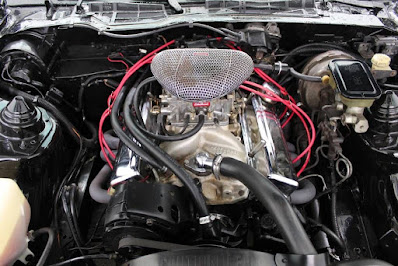Even as big a fan of the second generation Camaro and Firebird as I was, I knew it was time for new models when the new ones rolled out in the fall of 1981. After all, GM had built the previous models for twelve model years going back to 1970. It being the height of the "Malaise Era" of cars, where everything new was smaller, lighter, slower and not as good looking as it had been, I was pleasantly surprised by the looks of the Camaro whereas I could have cared less about the Firebird. Even the Trans AM.
From the bowling ball center wheels, which our subject is missing, to the overly swoopy hood to the flip up headlamps, every time I see a Firebird from this era I immediately say, "I'd rather have a Camaro". And when I see a third gen Camaro I say, "I wish it was a second gen". Here's a fun fact, that hood bulge on the left side of the hood is there to make way for the turbocharged Pontiac 301 V-8 that was pulled from production just as the design was approved for these cars. You'll find that bulge, which I actually think is pretty damn cool, only on 1982-1984 Trans Am's.
Part of the problem with this car in particular and its cousin the Camaro Z28 was that it was born with the infamous, "Cross-Fire Injection" fuel injection system. It's the same system Chevrolet used on 1982, 1984 and early 1985 Corvette's albeit on their 350 cubic-inch engine and not the 305 like they used on Trans AM's and Z28's. Pontiac started using Chevrolet V-8's in 1982 because they didn't make V-8 engines after 1981.
Cross-Fire engines used two throttle body fuel injection systems that fed air and fuel to the opposite banks they sat on. Feeding opposite banks, hence the silly "Cross-Fire" nomenclature, wasn't the problem as much as it was an unnecessarily complicated system that was fussy to tune properly. It being the advent of electronic engine controls and what not, properly trained technicians were few and far between. Us backyard shade tree guys hadn't a clue as to what to do with them.
The other engine offered on T/A's and Z28's of this vintage was the LG4 engine with an electronically controlled four-barrel carburetor. Despite making some twenty less horsepower than the Cross-Fire (LU5) engine, at least in terms of reliability and serviceability it was the superior engine. Bolted to a 5-speed, the difference between the two engines was negligible. It's no wonder our '83 here has what appears to be the stroker of all stroker engine swaps. Look, headers.
Of course, there's no info on what the engine has in it but what appears to be tasty albeit pricey package does come with a Hurst shifter as well. No doubt this thing can really move. Just wish it was a Camaro.
Here's the listing. Ad says retail price is $19,000. Too funny. Don't miss out!







No comments:
Post a Comment